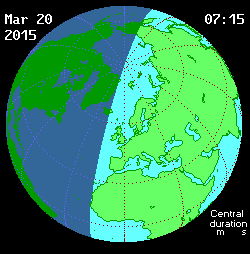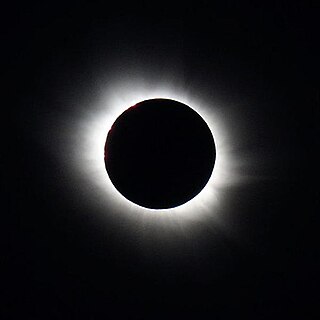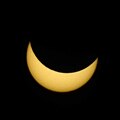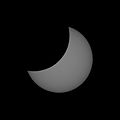Top Qs
Timeline
Chat
Perspective
Solar eclipse of March 20, 2015
Total eclipse From Wikipedia, the free encyclopedia
Remove ads
A total solar eclipse occurred at the Moon's descending node of orbit on Friday, March 20, 2015,[1] with a magnitude of 1.0445. A solar eclipse occurs when the Moon passes between Earth and the Sun, thereby totally or partly obscuring the image of the Sun for a viewer on Earth. A total solar eclipse occurs when the Moon's apparent diameter is larger than the Sun's, blocking all direct sunlight, turning day into darkness. Totality occurs in a narrow path across Earth's surface, with a partial solar eclipse visible over a surrounding region thousands of kilometres wide. Occurring about 14 hours after perigee (on March 19, 2015, at 19:40 UTC), the Moon's apparent diameter was larger.[2]
Totality was visible in the Faroe Islands and Svalbard. A partial eclipse was visible for parts of Greenland, Europe, North Africa, Central Asia, and western Russia. This total solar eclipse is notable in that the path of totality passed over the North Pole.
The longest duration of totality was 2 minutes and 47 seconds off the coast of the Faroe Islands. It was the last total solar eclipse visible in Europe until the eclipse of August 12, 2026.[3]
Remove ads
Event
Summarize
Perspective
Simulation


The solar eclipse began at 08:30 GMT in northwest Europe, and moved towards the northeast, but was still in northern Europe. It was most visible from the North Atlantic and Arctic Oceans, Greenland, Iceland, Ireland, the United Kingdom, Faroe Islands, northern Norway and Murmansk Oblast. The shadow began its pass off the south coast of Greenland. It then moved to the northeast, passing between Iceland and the United Kingdom before moving over the Faroe Islands and the northernmost islands of Norway. The shadow of the eclipse was visible in varying degrees all over Europe.[4] For example, London experienced an 86.8% partial solar eclipse while points north of the Faroe Islands in the Norwegian Sea saw a complete solar eclipse.[5] Three chartered airliners flew above the clouds, giving passengers a slightly prolonged view.[6]
The eclipse was observed at radio frequencies at the Metsähovi Radio Observatory, Finland, where a partial eclipse was seen.[7] The eclipse was also observed by meteorological satellite Meteosat-10.[8][9]
Impact
This section needs to be updated. (May 2017) |
The European Union has a solar power output of about 90 gigawatts and production could have been temporarily decreased by up to 34 GW of that dependent on the clarity of the sky. In actuality the dip was less than expected, with a 13 GW drop in Germany happening due to overcast skies.[10][11] This was the first time that an eclipse had a significant impact on the power system, and the electricity sector took measures to mitigate the impact. The power gradient (change in power) may be −400 MW/minute and +700 MW/minute. Places in Netherlands, Belgium and Denmark were 80-85% obscured.[12][13][14] The temperature drops varied greatly across Europe, with most areas having an insignificant drop in temperature due to the overcast weather, while others, like Scotland, Wales, and Iceland received a drop of 2-4°C. These areas were not obscured by cloud cover during the eclipse which may have led to the drop in temperature. Wind speed in the UK dropped by ~9%.[15]
Coincidence of events
In addition to the eclipse, 20 March 2015 was also the day of the March equinox (also known as the spring or vernal equinox in the Northern Hemisphere). In addition, six supermoons were expected for 2015. The supermoon on 20 March 2015 was the third of the year; however, it was a new moon (near side facing away from the Sun), and only its shadow was visible.[16]
At greatest eclipse, the Sun was at its zenith less than 24 kilometres (15 mi) south of the Equator. Greatest eclipse occurred at 09:45:39 UTC of Friday, March 20, 2015, while March Equinox occurred at 22:45:09 UTC, just under 13 hours after the greatest eclipse (Greatest eclipse occurred in winter, 13 hours before spring).
Religious significance
Proponents of the Blood Moon Prophecy, such as Bob O'Dell[17] also pointed out that 20 March 2015 was also a significant day on the Jewish and Biblical calendar. That evening was the onset of the Hebrew month of Nisan, the first month in the Biblical calendar year. Furthermore, the path of the total eclipse over the North Pole[18] was a highly symbolic location infusing the day with both great natural significance and profound religious meaning according to O'Dell. Due to the significance of the eclipse, a global prayer event in Jerusalem was organized that day.[19]
Remove ads
Eclipse timing
Places experiencing total eclipse
Places experiencing partial eclipse
Remove ads
Eclipse visibility
Summarize
Perspective
The event was visible as a partial eclipse all across Europe including: Norway, Sweden, Denmark, the United Kingdom,[20] Ireland,[21] Portugal, France,[22] Germany,[23] Poland,[24] Czech Republic, Slovakia, Hungary, Austria, Italy, Montenegro, Finland, Western Russia, and Ukraine.
- Sheffield, United Kingdom. All time local time (GMT)
- Lorient, France, 10:20 local time (9:20 GMT)
- Berlin, Germany, 10:29 local time (9:29 UTC) – unconfirmed source
- Markt Schwaben, Germany
- Dublin, Ireland, 9:30 GMT
- Chester-le-Street, United Kingdom, 9:36 GMT
- Tórshavn, Faroe Islands, End of totality, 9:43 local time (GMT)
- Wrocław, Poland, 10:44 local time (9:44 UTC)
- Hjartdal, Norway, 10:47 local time (9:47 UTC)
- Prague, Czech Republic, 10:49 local time (9:49 UTC)
- Kłodzko, Poland, 10:54 local time (9:54 UTC)
- Warsaw, Poland, 10:56 local time (9:56 UTC)
- Budapest, Hungary, 11:00 local time (10:00 UTC)
- Bregenz, Austria, 11:06 local time (10:06 UTC)
- Milan, Italy, 11:08 (10:08 UTC) – unconfirmed source
- Petrozavodsk, Russia, 13:25 local time (10:25 UTC)
- Kyiv, Ukraine, 12:28 local time (10:28 UTC)
- Ulcinj, Montenegro, 11:34 local time (10:34 UTC)
- Moscow, Russia, 13:35 local time (10:35 UTC)
- Leeds, United Kingdom, 10:30 UTC/GMT
Eclipse details
Summarize
Perspective
Shown below are two tables displaying details about this particular solar eclipse. The first table outlines times at which the Moon's penumbra or umbra attains the specific parameter, and the second table describes various other parameters pertaining to this eclipse.[25]
Remove ads
Eclipse season
This eclipse is part of an eclipse season, a period, roughly every six months, when eclipses occur. Only two (or occasionally three) eclipse seasons occur each year, and each season lasts about 35 days and repeats just short of six months (173 days) later; thus two full eclipse seasons always occur each year. Either two or three eclipses happen each eclipse season. In the sequence below, each eclipse is separated by a fortnight.
Remove ads
Related eclipses
Eclipses in 2015
- A total solar eclipse on March 20.
- A total lunar eclipse on April 4.
- A partial solar eclipse on September 13.
- A total lunar eclipse on September 28.
Metonic
- Preceded by: Solar eclipse of June 1, 2011
- Followed by: Solar eclipse of January 6, 2019
Tzolkinex
- Preceded by: Solar eclipse of February 7, 2008
- Followed by: Solar eclipse of April 30, 2022
Half-Saros
- Preceded by: Lunar eclipse of March 14, 2006
- Followed by: Lunar eclipse of March 25, 2024
Tritos
- Preceded by: Solar eclipse of April 19, 2004
- Followed by: Solar eclipse of February 17, 2026
Solar Saros 120
- Preceded by: Solar eclipse of March 9, 1997
- Followed by: Solar eclipse of March 30, 2033
Inex
- Preceded by: Solar eclipse of April 9, 1986
- Followed by: Solar eclipse of February 28, 2044
Triad
- Preceded by: Solar eclipse of May 19, 1928
- Followed by: Solar eclipse of January 19, 2102
Solar eclipses of 2015–2018
This eclipse is a member of a semester series. An eclipse in a semester series of solar eclipses repeats approximately every 177 days and 4 hours (a semester) at alternating nodes of the Moon's orbit.[26]
The partial solar eclipse on July 13, 2018 occurs in the next lunar year eclipse set.
Saros 120
This eclipse is a part of Saros series 120, repeating every 18 years, 11 days, and containing 71 events. The series started with a partial solar eclipse on May 27, 933 AD. It contains annular eclipses from August 11, 1059 through April 26, 1492; hybrid eclipses from May 8, 1510 through June 8, 1564; and total eclipses from June 20, 1582 through March 30, 2033. The series ends at member 71 as a partial eclipse on July 7, 2195. Its eclipses are tabulated in three columns; every third eclipse in the same column is one exeligmos apart, so they all cast shadows over approximately the same parts of the Earth.
The longest duration of annularity was produced by member 11 at 6 minutes, 24 seconds on September 11, 1113, and the longest duration of totality was produced by member 60 at 2 minutes, 50 seconds on March 9, 1997. All eclipses in this series occur at the Moon’s descending node of orbit.[27]
Metonic series
The metonic series repeats eclipses every 19 years (6939.69 days), lasting about 5 cycles. Eclipses occur in nearly the same calendar date. In addition, the octon subseries repeats 1/5 of that or every 3.8 years (1387.94 days). All eclipses in this table occur at the Moon's descending node.
Tritos series
This eclipse is a part of a tritos cycle, repeating at alternating nodes every 135 synodic months (≈ 3986.63 days, or 11 years minus 1 month). Their appearance and longitude are irregular due to a lack of synchronization with the anomalistic month (period of perigee), but groupings of 3 tritos cycles (≈ 33 years minus 3 months) come close (≈ 434.044 anomalistic months), so eclipses are similar in these groupings.
The partial solar eclipses on March 27, 1884 (part of Saros 108) and December 24, 1916 (part of Saros 111) are also a part of this series but are not included in the table below.
Inex series
This eclipse is a part of the long period inex cycle, repeating at alternating nodes, every 358 synodic months (≈ 10,571.95 days, or 29 years minus 20 days). Their appearance and longitude are irregular due to a lack of synchronization with the anomalistic month (period of perigee). However, groupings of 3 inex cycles (≈ 87 years minus 2 months) comes close (≈ 1,151.02 anomalistic months), so eclipses are similar in these groupings.
Remove ads
References
Bibliography
External links
Wikiwand - on
Seamless Wikipedia browsing. On steroids.
Remove ads



















































































































